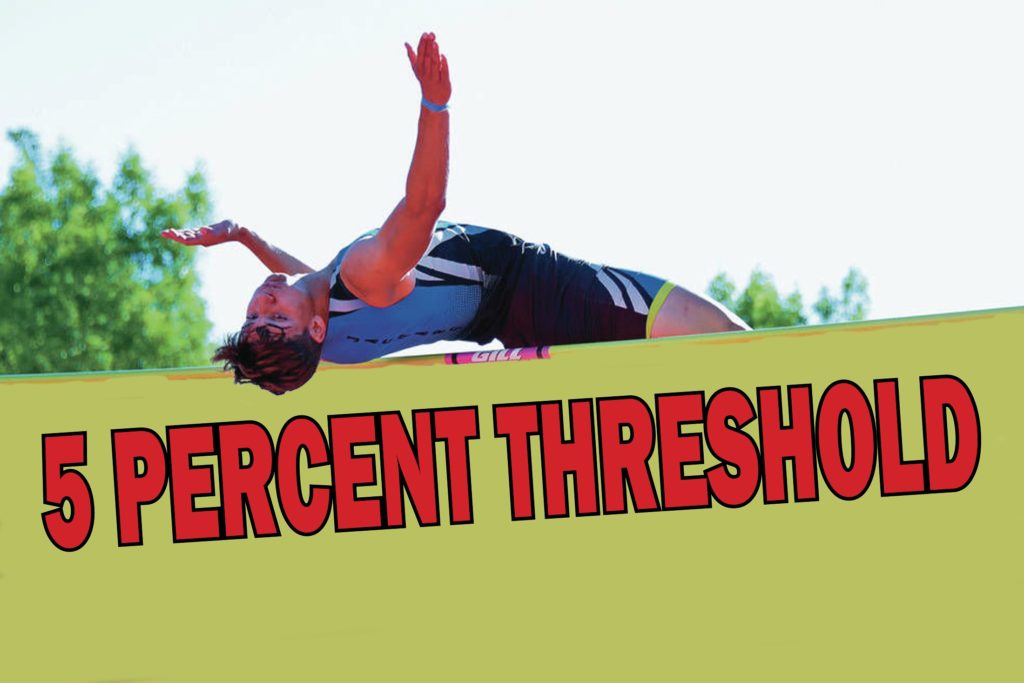How To Get Rid Of The 5% Threshold Without Empowering Extremists

New Zealand runs elections under a Mixed Member Proportional system, meaning that parties contesting the election win a number of seats in Parliament proportional to how many votes they receive. This system has advantages and disadvantages, one of the latter being that it facilitates extremists coming to Parliament. Various methods have been adopted to counter this, such as a 5% threshold – this essay suggests a more elegant solution.
As John F Kennedy warned us, “Those who make peaceful revolution impossible make violent revolution inevitable.” Although it’s never admitted, the purpose of the democratic system is to pre-empt the violence that inevitably follows when people are not given a say in their own destiny. The problem with totalitarianism is that people resent it, and if they resent it enough they end up killing their rulers.
Democracy is a charade in which the ruling class pretends to take the opinion of the working classes seriously, in exchange for a dampening of revolutionary sentiments among those working classes. If the ruling class can successfully placate the workers, then they can continue to do as they please. If they cannot, then resentment will arise, and this will eventually lead to radical extremism.
Kennedy might have warned us that a 5% threshold to get into the New Zealand Parliament creates a number of problems.
It is set so high that no new party has ever crossed it. In 24 years of MMP elections, the only parties to achieve representation apart from National and Labour were parties that broke away from them (New Zealand First and United Future from National, ACT from Labour, the Greens from the Alliance that itself broke from Labour).
The ruling class considers this a win, but the people consider it a great loss. It has meant that no opinion, other than the mainstream ones, can find expression in Parliament. Only those opinions that have been so thoroughly vetted and curated by the Establishment that they pose no threat are allowed into the House of Representatives. This does little to soothe the people’s feelings of frustration.
It could be argued that having a 5% threshold leads directly to things like the Christchurch mosque shootings. The mass immigration of the last half a century has caused immense resentment among the many who have lost out from it, but their voices are silenced by a system that profits heavily from the cheap labour. Sentiments like these are liable to boil over into xenophobic violence on occasion – a pattern that has been seen all around the world.
There is a possible solution to these tensions – one that has never previously been tried. This is to firstly scrap the 5% threshold, and secondly for each voter to have three votes instead of one. Two of the votes can be cast for any candidate or party, much like the current system, but one vote can only be cast against a candidate or party. This anti-vote cancels out one of someone else’s votes for a certain party.
Having two positive votes, one negative vote and no threshold means that (in theory) small parties who do not engender hatred can still achieve representation in Parliament, while the extremists who do engender hatred get eliminated by the negative votes.
Parties like the Aotearoa Legalise Cannabis Party, Social Credit, or The Opportunities Party, who have unfashionable ideas but who are not malevolent or extremist, ought to be able to take some seats in Parliament. The ideas that these parties represent are long overdue for serious consideration, but the 5% threshold has prevented them from ever being represented.
Other parties like the New Conservatives, who combine popular ideas like ending mass immigration with horrendous human rights abuses like increasing penalties for cannabis use, are the reason for the 5% threshold in the first place. It was precisely to keep aggressive, narcissistic, Bible-thumping morons like them away from power that the 5% threshold was invented.
In practice, we could expect that parties like the New Conservatives would attract a high number of negative votes. If the total number of negative votes for a given party was greater than the total number of positive votes, they would receive no seats. Therefore, the ability to cast a negative vote would mean that human rights abusers could be kept out of Parliament, but not at the expense of other small parties who have ideas the country needs to hear.
Then again, Germany has a 5% threshold (our version of MMP was modelled on theirs) and they have six parties currently polling well over that. So it could be argued that the New Zealand political class severely lacks imagination, which is the reason why no party other than Labour, National, Greens or New Zealand First has ever presented a compelling enough case to get over the threshold.
The positive/negative vote model would allow our electoral system to not only measure and weigh the sympathy of the public for the various political platforms, but also to measure and weigh their antipathy for those platforms. The biggest advantage with this suggestion is that platforms that inspired disgust, hatred and contempt would now find themselves judged for that, instead of getting away with it.
*
If you enjoyed reading this essay, you can get a compilation of the Best VJMP Essays and Articles of 2019 from Amazon for Kindle or Amazon for CreateSpace (for international readers), or TradeMe (for Kiwis). A compilation of the Best VJMP Essays and Articles of 2018 and the Best VJMP Essays and Articles of 2017 are also available.
*
If you would like to support our work in other ways, please consider subscribing to our SubscribeStar fund. Even better, buy any one of our books!





